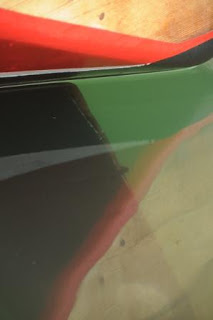They (the boat owning community) say that b.o.a.t. is really just an acronym for bring out another thousand. I’m inclined to agree with them. They call boats money pits, big holes in the water that you throw money into. The name Kala Lua is emblazoned on the transom (back) of Jeff’s parents’ beautifully handcrafted Bartender. Kala Lua is Hawaiian for money pit. Cruising has been described to us (on numerous occasions) as ‘fixing your boat in exotic locations.’ They say that if you’re interested in buying a boat, it would be more cost effective to put your money
in a pile and burn it. They’re mantras that members of the boating community repeat to themselves and to each other, always with a laugh, or an elbow jab or a wink. All true statements, but it doesn’t stop them…or us. Mostly because people who own boats are on the crazy side of sane.
I was sitting on the starboard (rightside) settee the other day transcribing interviews (work I’m doing for my former grad school adviser). Jeff was clambering around on deck doing various repairs that have found their way to the top of our list. He suddenly stopped clambering and silently entered the cabin, grabbed the 12 volt blower that we use to blow up our impossibly tiny dinghy, the extension cord for said blower and returned outside with a sense of purpose. I was confused…why is he blowing up the dinghy, we’re at a dock…we don’t need the dinghy…maybe he’s using the blower for something else?
He inflated the dinghy and without one word, climbed in and proceeded to sit in it in the back of our boat staring at something.
He returned to the cabin several minutes later. Motioned for me to take out my earbuds and in a very calm and soothing voice, said that he had something to tell me, and that it’s “not exactly good news.” In my head I was
trying to connect the bad news with the fact that he’d just blown up the dinghy and that he was also remarkably calm to be the bearer of truly bad news.
So I convinced myself that the dinghy must have sustained some damage at Shelter Cover after all
No big deal, I was mentally preparing myself, I can patch that up in no time.
He pointed past the dinghy, to the rudder. “See there?”
“Where? What am I looking at?”
“Our rudder, it’s splitting like a banana.”
 Look closely, under the water…the black thing is our rudder, and it’s not supposed to have that big gap in it (towards the top you can see the split).
Look closely, under the water…the black thing is our rudder, and it’s not supposed to have that big gap in it (towards the top you can see the split).
It’s an apt description for a terrible phenomenon. Our theory (after doing lots of research on the internet) is that while we were on the hard, the rudder had a chance to heat up and start cracking. We believe it to be a metal frame
that is mostly hollow inside and has been glassed over to maintain its shape and provide enough surface area to press against the water. All of the pounding from the pursuing waves must have put too much pressure on the rigid
shell. We’re lucky that Jeff noticed it while we’re safe in the San Francisco Bay. Without a rudder we can’t steer our boat. It’s not a fun discovery now…but it could be a catastrophic discovery in the middle of a squall on the Pacific.
At this point I crumbled onto the dock, knees pulled towards chin. Another repair…we just got done
repairing the keel and the bow stem (which are both pretty major repairs).
Jeff, still calm, saw the defeat in my eyes, squatted next to me and slowly rubbed my back, with the banana gap staring us both down.
“I wish there was someone here to tell us, ‘this is no big deal, you can fix this, no problem.’” I said. These are exactly the words, oft repeated, by lots of people we trust. These words got me through our time in Ilwaco.
“We’re those people now.” Responded Jeff. “I know we can get this done, it’s just going to take some time.”
He’s right. It’s just us now. A whole village helped get us through the repairs while we were in Ilwaco and in a lot of ways that experience equipped us with the stubbornness and skills to look at a problem like this and say, “yes, we can do this…this isn’t the end of the world.” Spending the money still stings, but we both expect that it will be a relatively “cheap” repair and at least we have some time and some know how.
First on the list is removing the rudder shaft collar (the big hunk of metal that keeps the rudder attached to the boat), which appears to be “frozen” (ie it’s so corroded it’s basically welded together). Jeff has tied some line to the rudder and has also placed a hammock beneath it so that the rudder doesn’t sink to the bottom of the harbor when it detaches. A brilliant idea that he adapted from Calder’sBoatowner’s Mechanical and Electrical Manual (a good buy if you own a boat).
Stay tuned for news re: THE RUDDER DISMANTLEMENT AND REPAIR!
 We’re finally using that hammock.
We’re finally using that hammock.